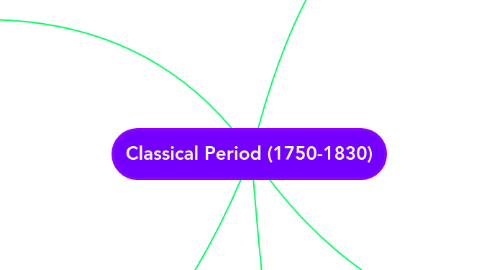
1. 2. Significant contributions/changes
1.1. Piano
1.1.1. Solo pieces => Sonatas
1.2. Public concerts
1.2.1. Music = welcome to everyone (the common person)
1.3. Orchestra
1.3.1. Harpsichords and organs were not the orchestra's musical foundation.
1.3.2. Wind instruments joined in and assumed dominant parts.
1.4. String Quartet
1.4.1. 2 violins, 1 viola, 1 cello
1.4.2. 4-movement format
1.5. Symphony
1.5.1. 3-movement format with opening
1.5.2. Changed to become expansive 4-movement format
1.6. Opera
2. 1. History
2.1. General
2.1.1. Age of Enlightenment
2.1.1.1. Art, literature, architecture - Greece and Rome
2.1.1.1.1. 1813: Pride and Prejudice is published.
2.1.2. 1760: Coronation of King George III
2.1.3. 1778 (Milan): La Scala Opera House
2.1.4. 1804: Napoleon becomes emperor of France.
2.2. Music-related
3. 3. Important Composers
3.1. Wolfgang Amadeaus Mozart (1756-1791)
3.1.1. Compositions (626)
3.1.1.1. Operas
3.1.1.2. Concertos
3.1.1.3. Symphonies
3.1.1.4. Chamber music
3.1.1.5. Choral compositions
3.2. Joseph Haydn (1732-1809)
3.2.1. Compositions
3.2.1.1. 107 symphonies
3.2.1.2. 83 string quartets
3.2.1.3. 45 piano trios
3.2.1.4. 62 piano sonatas
3.2.1.5. 14 masses
3.2.1.6. 26 operas
3.3. Ludwig Van Beethoven (1770-1827)
3.3.1. Compositions
3.3.1.1. Symphonies
3.3.1.2. Piano sonatas
3.3.1.3. 1 opera
4. 5. Style
4.1. Formality
4.1.1. Elegance
4.1.2. Restraint
4.1.3. Structural clarity
4.2. Objectivity
5. 4. Musical Elements and Structure
5.1. Sonata form
5.2. Thematic development
5.3. Classical choral music = homophonic and lighter in texture
5.3.1. Conservative
5.3.2. Lightness of phrasing

